Solo exhibition at the Victoria Arts Council satellite gallery at Victoria International Airport. September 27, 2021 – January 10, 2022.






Solo exhibition at the Victoria Arts Council satellite gallery at Victoria International Airport. September 27, 2021 – January 10, 2022.






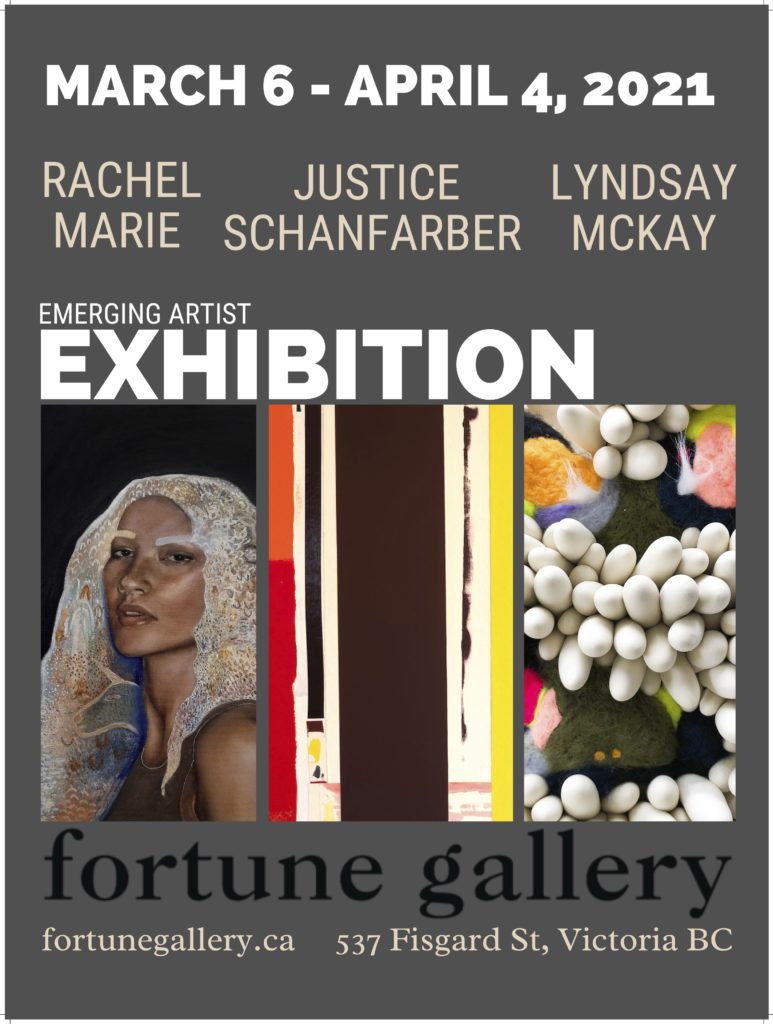
I’m showing a selection of artworks at Fortune Gallery in historic Chinatown in Victoria BC from March 5 – April 4, 2021. It’s a group show of three emerging artists that includes Victoria artists Rachel Marie and Lyndsay Mckay. Check out their work; it’s really worth a look. It’s an honour to be selected for this show and to be exhibiting in such good company.
The artworks I’ve chosen for this exhibit include a larger painting from my inaugural show “You see me like this“, two triptychs from my “Splice” show, and some additional assemblage pieces from my series “On Use” that I’ve never shown publicly. None of this work has been shown in Victoria.
Fortune Gallery is a commercial gallery; all works are for sale.



Justice Schanfarber
Refuge (2019)
House paint on canvas and vintage mill paper adhered to wood panel
48×84″
The refuge we choose is not always the refuge we seek. We might settle for an uneasy respite from the storm even though our instincts tell us to be cautious. The hardship we escape is exchanged for new dangers.
Justice Schanfarber on his artwork “Refuge”

Justice Schanfarber
A quiet knowing (2019)
Paper assemblage and paint
25×16″
Plenty of knowing is loud. Much knowing demands to be pronounced, to be heard. Occasionally though we might feel a quieter knowing, a knowing that needs no announcing, that is wholly internal and self-validated.
Justice Schanfarber on his artwork “A quiet knowing”
I’m showing a new painting at the 39th annual members show at the Campbell River Art Gallery. The show runs January 14 – February 20, 2021, and is co-hosted by the Campbell River Arts Council. Head down to the gallery, or you can view the show online here.


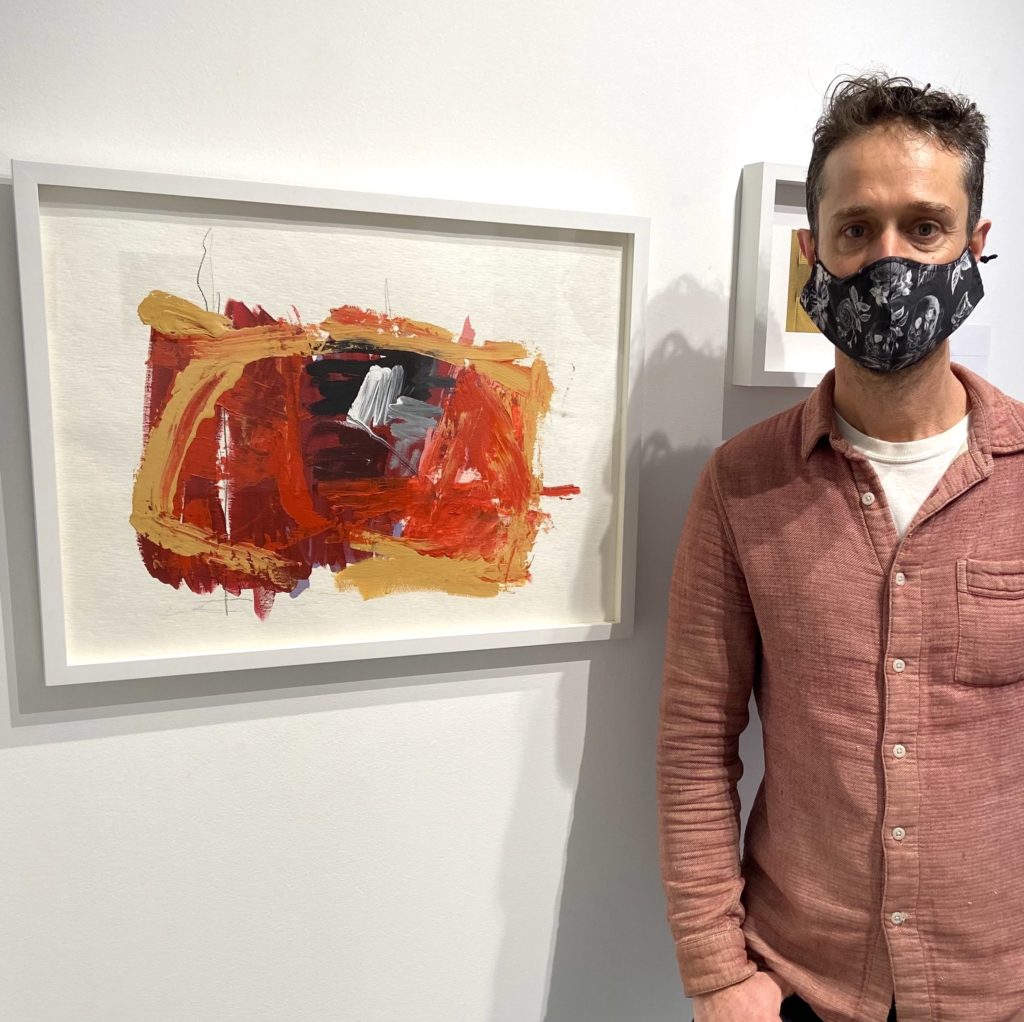
Justice Schanfarber
Volume (2020)
House paint and graphite on vintage mill paper
18×24″
Wild abandon never guarantees a favourable outcome, but sometimes, if you call it out from the heart, and manage to recognize its limits and to steer it away from total destruction, it shakes loose a blessing that careful consideration on its own never can.
Justice Schanfarber on his artwork “Volume”

I’ve been composing the various elements of this piece since 2018, and I’ve spent the last few days putting them together in an interesting (and rather large) assemblage that I am calling “On Use”.
On Use reflects my attraction to objects, especially wood (appropriate, given where I live in the Pacific Northwest/Salish Sea region), that have been discarded after reaching the end of their utility. It’s an exploration of use, misuse, right use, and abuse, and also of the continuum between utility and beauty.
The unceremonious disposal of these objects is countered by the “ceremony” of recognizing their post-use aesthetic and then bringing it out through composition. The implication is that only after their useful life is finished can certain objects reveal their deeper character.
“Used” (found, salvaged, discarded, left-over) materials form a foundation for my art practice, not only for their explicit materiality but also in how they shape a process, and because of the particular demands they place upon the imagination.
With used materials there is no Tabula rasa, no blank slate, no blank canvas. It is a different kind of relationship, partly pre-formed or destined, beginning with a recognition (even an honouring) of what is already there, of what has already been lived.
On Use is assembled on thick vintage mill paper from the now defunct pulp mill just outside the town of Campbell River. The paper was previously used by me, providing various functions in the studio. I chose to work with its marks and dimensions as-is, inviting more embedded history into the work rather than trying to create an invisible or “clean” background.
The work is assembled in such a way that it can be taken apart without damaging its components. It may turn out to be a temporary piece, or it may have a long life in its current form. It is now hanging above the kitchen table, where it fills the wall. The weight of the piece, combined with some buckling of the very thick paper, has it leaning out in somewhat unevenly, emphasizing its three-dimensional presence in the room.
On Use is 60×70″. Materials include wood, plywood, paint, pencil, crayon, rope, fabric, paper, cardboard, canvas, and hardware.






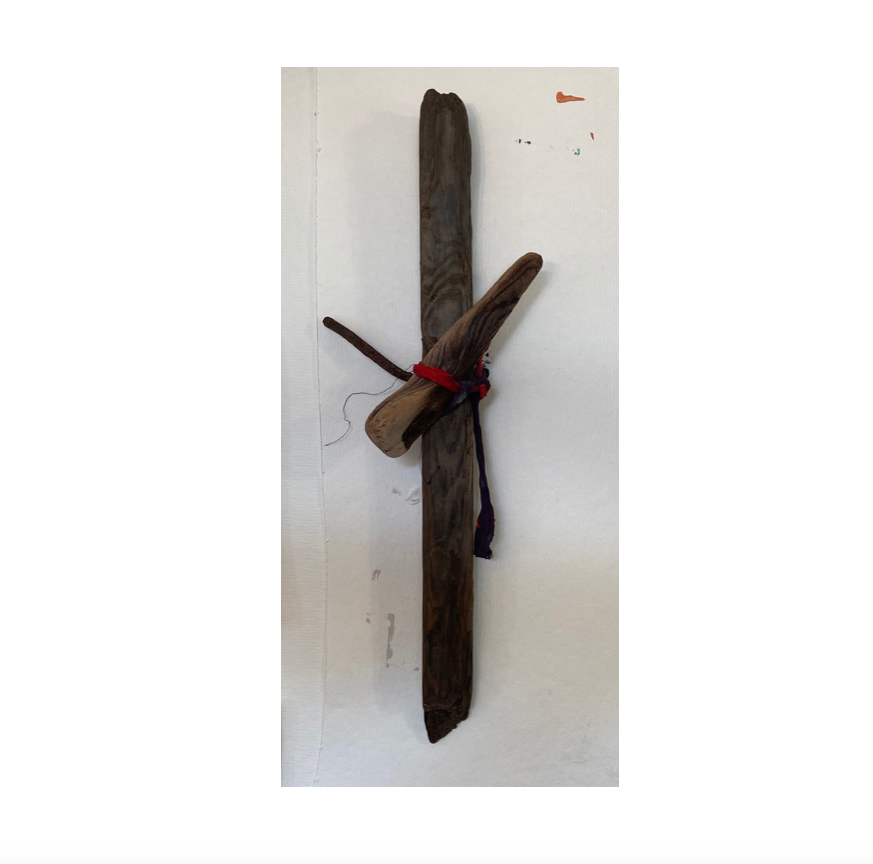





The wood at the center is cedar, a discarded piece of dunnage from a tree that defines the place I live, used to protect or facilitate the commerce of something unknown and since gone. This piece of wood made an immediate impact on me so I took it home and spent some time with it. It came to signify something, something dignified, a particular dignity that can come with age and even decay, with being used by life and showing said use.
Surfaces have been worn and worn away, fibers that were not integral have been digested; what remains is concentrated, an essence of character. It took me several months to recognize this, and then I couldn’t see it otherwise.
How could I emphasize what I was seeing, bring it out, reveal it?
As a form, the triptych has special qualities, reminders of all to do (and it’s a lot!) with thirds and threes, especially third paths, third ways, and the third possibilities that jump rail and disrupt the common dualities of the day.
The painted white canvasses elevate, like wings (angel wings?), that which is clearly on the path of descent, holding the motion in place, that the assembly might now hover in sight.
“Dignity” grabbed the attention of a number of people when I showed it at my Splice exhibit, and I enjoyed the opportunity to talk about the piece and see it through new eyes.
Barb Hunt took the photo at the top, and I love the subdued Wes Anderson-esque symmetry. Sarmad Al Mouallem got a nice shot of me and glass artist Bob McLeod talking about the work (below).

In June 2020 Dignity was exhibited in the Ministry of Casual Living Window Gallery in Victoria BC.
My statement for the exhibit reads –
I grew up in Victoria in the 80s, at a time of rapid change and development. Although I was young I could feel something of the (rough) character and (precarious) dignity of the town being stripped away, covered with new facade. The Eaton store downtown exemplified this.
At that time (c 1985/86) I was an adolescent punk rocker hanging out precisely where the window gallery is now located, in what was then known as piss alley, adjacent to the Odeon theatre.
When I return to Victoria, now on my way toward elderhood, elderhood with all its lines and crevices and etched histories, I marvel at the changes, and at my own (perhaps necessarily cliched) wonder at the felt experience of aging and the accompanying revelation of character.
I’m honoured and touched to be welcome here, to be included again, and to be able to show my work in this place that meant so much – glorious and terrible – to a former self.



The dawn broke is an exhibit comprised of four mixed media / collage works paired with a poem. The poem can be presented as a printed paper handout and/or as vinyl text on the gallery wall.
This work is about finding natural balance and buoyancy in the world just as it is, as we are. Earth tones and salvaged kraft paper speak to the inescapability of our connection to earthly forces, despite our many and varied attempts otherwise. The poem, originally self-published in a chapbook in 2013, is a humorous and poignant nod to the human desire to improve or elevate everything to do with ourselves.

“What the dawn said”
The dawn broke
and it told me
You don’t have
to be amazing
There’s no special
thing you need
to accomplish
in this life
No great potential
you must meet
What is the
opposite of
amazing? asked
the morning light
You needn’t be
that either
No matter what
your friends pretend
on facebook
Awesome
is a cheap game
for the uninitiated
Every leaf knows better
and so do you
Hang out with
me a while
chirped the robin
as she did
her thing
(you know –
the stuff robins
do without really
thinking about it)
It was very
uninspiring
nothing great about
it at all
Then the honeybees did
their dance
and someone got
very excited and
called it a
miracle
Not really said
one of the bees
I’m just doing
what feels right
and soon – in a week or two
I’ll be dead and my family
will push my body out onto the ground
But I insist
on the awesomeness
of being awesome!
boomed a voice
Haven’t you heard about crowdsourcing and 3-D printing?
What about TED talks
and following your passion
for making the world a better
and really interesting place?
And google goggles!
You can make a
big noise if you like
said the sunset
And the waves chuckled
good-naturedly
as they
rolled
in
and
out





[Photos Sarmad Al Mouallem unless otherwise indicated.]
I make large and small paintings that sometimes include collage and assemblage. My work could be reasonably categorized as abstract contemporary.
The purpose of my art practice is to engage with aesthetic forces that I do not understand. My relationship with these forces deepens over time and proximity, and also through the successful completion of work; hence my commitment to the practice of art making.
Working with unintended consequences is a crucial part of my practice. I take risks in materials and process, making mistakes and then working with the mistakes. In this way mistakes are refined and redefined, becoming synchronicities and blessings.
The drama and intrigue in my work can be applied to the issues of the day, seen through the lens of the issues of the day, without wholly submitting to the issues of the day. A flexibility of meaning is retained and the audience remains free to engage with the work on their own terms.

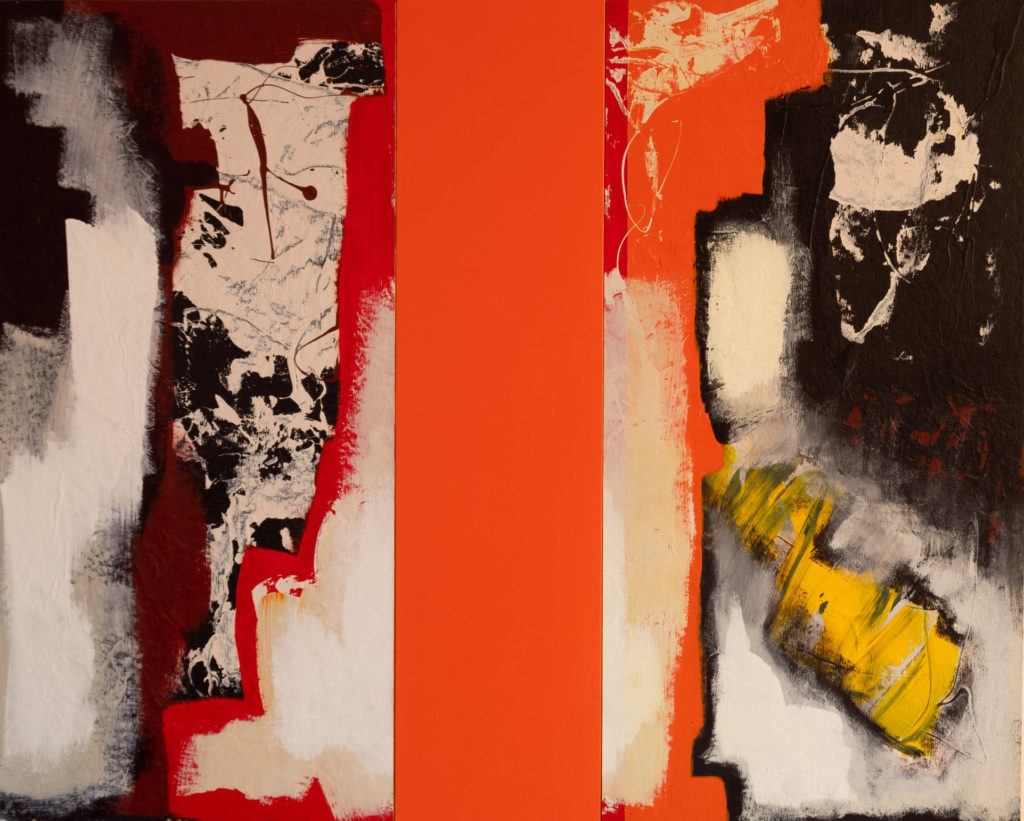







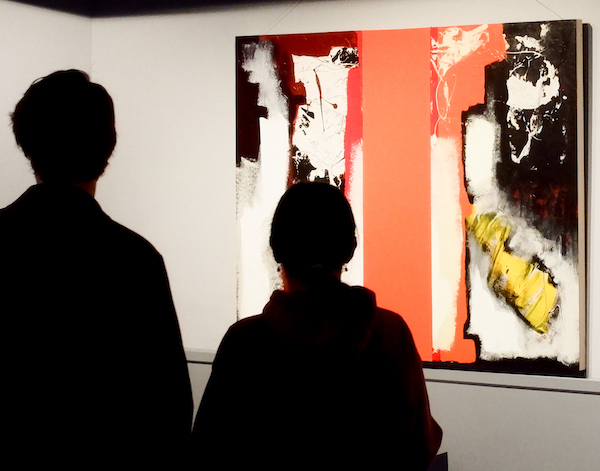





Less than a week ago coronavirus fears quickly escalated and the situation became suddenly dire. My teenage daughter and her mother were on their first major trip together, to Thailand. Fears about cancelled flights home and closed borders loomed and then were quickly realized.
It was a tense few days, with feelings of fear and helplessness that I’m frankly not accustomed to in recent times. Friends and family banded together; we all did what we could from where we were.
Today my daughter and her mother arrived home safely. I feel a deep relief even though uncertainty and a sense of impending danger continue to grow in the shadow of the global pandemic.
In this uncertainty there is a call for distancing ourselves from others in body. This distance is painful and confusing for many, but also necessary.
In a large country like Canada, distance is a familiar idea in some ways, and yet within this context it feels eerie and foreign, foreboding.
While my daughter and her mother faced an uncertain trip home to Canada, I felt the distance between us, not just in terms of miles (I never really did adjust to metric), but in terms of uncertainty and fear; the distance in the gap between what I could count on just a few days ago and what I could count on now. Everything seemed to hang in the balance of that gap.
And so when I wasn’t phoning the airline or the embassy, or strategizing with my amazing supportive partner Sue, I was working at my art. The piece I am sharing here came together precisely as the term “social distancing” became a sudden and irreversible part of the global narrative and lexicon, when my daughter’s safety felt terrifyingly out of my hands, and when, perhaps more than ever, I felt the pain and fear of distance.
(Below – Considering different mat colours.)


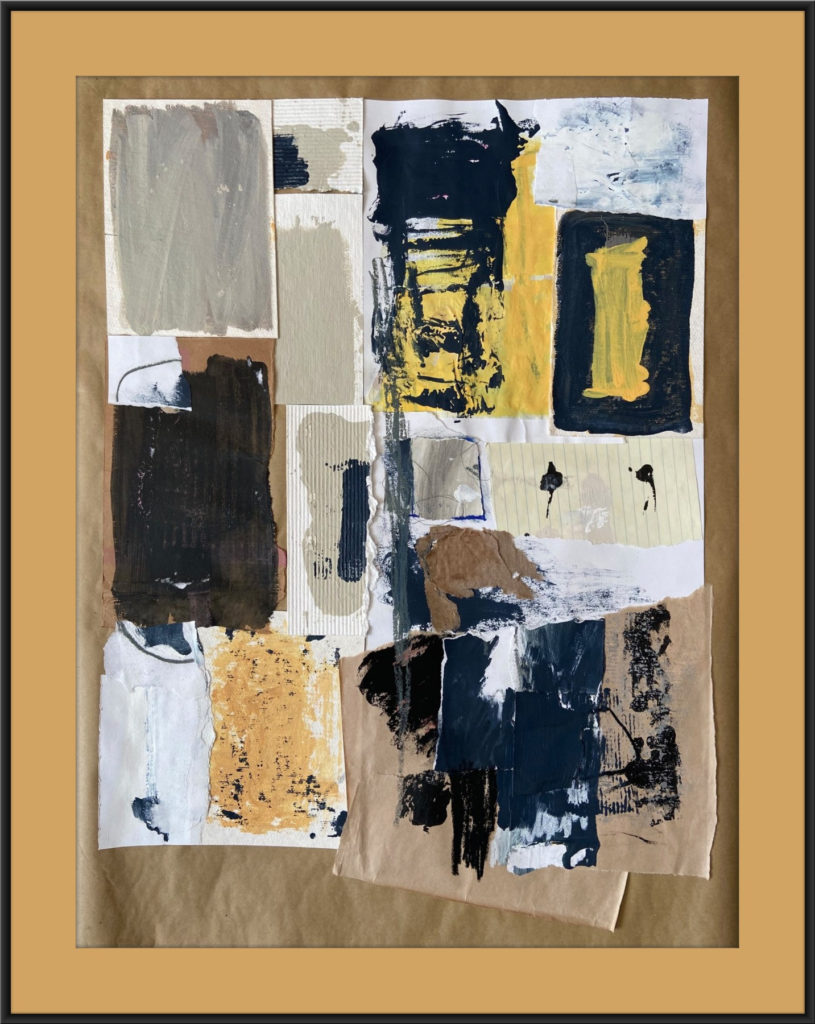
What if the dead dreamed the living to life?
In this piece the dead reside below and dream of the living who cavort above. It is through the dream of the dead that the living are animated. In this case, what is our debt to the dead? What do we owe all who have come, and departed, before us?
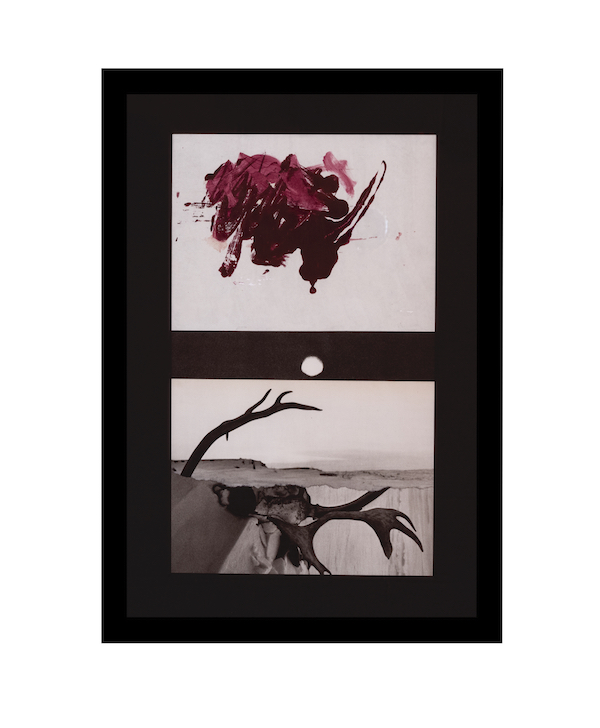
The below half of the work is assembled of “dead” or previously living materials, long still. The above half of the work is composed “alive” with gestural paint strokes on paper. There is no value judgement placed upon these differences; they are but two sides of a coin (a silver buffalo nickel perhaps).
The photographic image of the animal skull, found in a discarded book, is by celebrated Canadian photographer and painter Rollof Beny (my first introduction to the artist). By “killing” the image through a single decisive tear, then reviving it with a matching decisiveness, an additional horizon is formed and the animal is split in two, appearing to occupy dual strata beneath the full moon. Above, in painterly motion, a creature charges headlong into life.
Though they occupy different realms, a connection is implied through the moon hovering between them and a shared directionality of motion, a movement to the right, to the east, toward morning wakefulness, toward the rising sun.
“Each morning, we return from the dream soul trying to adjust to the day world, that moment when the two souls exchange places in the driver’s seat.”
~ James Hillman

Myths are timeless stories that locate us in the world (or more accurately, in the cosmos or greater order of all things, what we might contemporarily call the universe).
Myths locate us not only geographically and temporally – each place and time has its myths – they locate us culturally in the broadest sense of the word: Myths tell us about our relationships to others, to our human and non-human relatives, living and dead; myths inform us of our place in the world, perhaps even bestow it.
Every culture lives and has lived by their myths. These myths are either explicit or implicit. They are told with intention to illuminate or intention to obfuscate, or a bit of both. Joseph Campbell famously stated “Myth is what we call other people’s religion.”
Myth is inescapable, even in a contemporary society where god has been proclaimed dead. The only alternative to living consciously through myth is living unconsciously through myth.
I titled this piece “Do you want to hear a story.” Note that there is no question here. The chosen punctuation is a period. You WILL hear a story. We are living through our myths whether we recognize them or not. This particular piece contains mythological shadows, hinting at ancestral connections and journeys – heroic and otherwise – without an explicit narrative being revealed. It is up to the viewer to receive the story. I recommend meeting it on its own terms, letting it do its work on the psyche without too much interference or interpretive action. Let the images, textures, colour, shape sink in. The stories we receive in our culture tell us mercilessly what to do, what to believe, how to behave. Let the story in this work be different. Let it remind you of something you already know. Let the story be changeable. Consider that its opposites, in some circumstances, might also be true.
